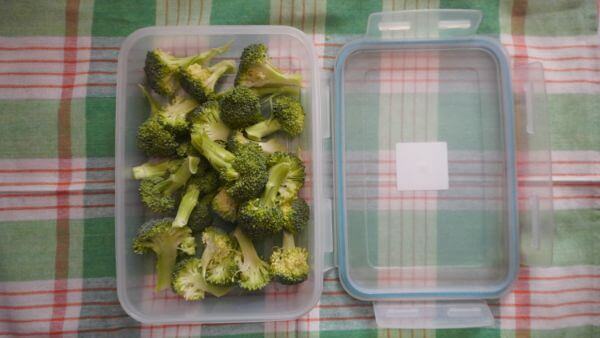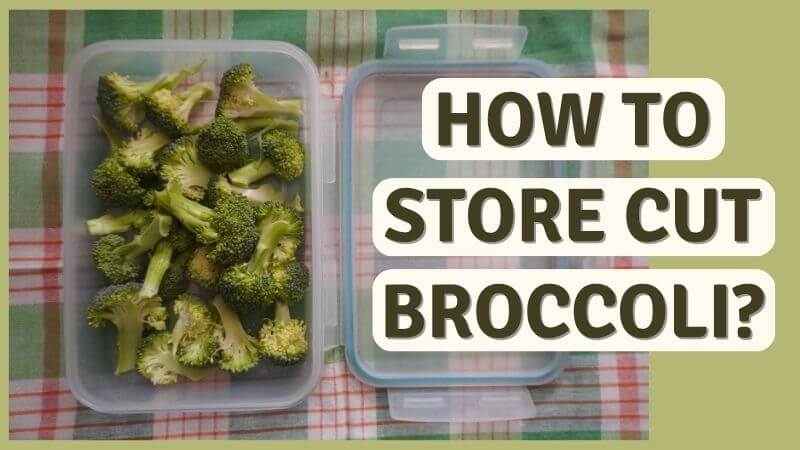Broccoli reminds me of home. The bottle-green spherical structure with little florets atop stout stems reminds me of the lofty hills clothed with dense jungles surrounding Kathmandu.
I was not too fond of broccoli as a child. As a matter of fact, this vegetable wasn’t found all over the place back then as it does now. I never had the chance to acquire a taste for this versatile, nutritious vegetable.
Learning to identify and pick the best pieces is crucial, as with any produce. But even more important is learning how to store it – cut, cooked, and whole.
In this article, we will discuss the best method to store cut broccoli so that it remains fresh for an extended period. We’ll also look into the correct method of freezing cut broccolis, so they last you for a year.
Table Of Content
How To Store Cut Broccoli?

Cut broccoli should be stored in an airtight container or bag in the crisper drawer where the temperature is 32-40 degrees Fahrenheit. Bear in mind that the cut pieces should be dry – moisture accelerates the rotting process. If stored correctly, your broccoli will remain fresh for over 5 days.
Wash Your Broccoli At The Eleventh Hour
Yes, I know – it sounds counterintuitive – but hold off on washing your broccoli until you’re actually gonna use it.
When storing broccoli, a little moisture is a good thing. Anything more than that will accelerate the rotting process. Wetness will create a suitable environment for mold growth, making the produce inedible in as little as a few days.
Having said that, know that these veggies come with residual pesticides – so don’t skimp when the time finally comes to wash the broccoli.
To start, you can soak it in warm/cool water for a couple of minutes. Next, give it a good rinse under running water while still in the colander.
Use An Airtight Container
It’s important – in fact, indispensable – to use an airtight container to store cut broccoli. There are many reasons behind it.
For starters, it will protect the produce from ethylene gas emitted by other vegetables and fruits present in the vicinity. An increase in ethylene concentration unsolicitedly increases the produce’s metabolism – leading to faster ripening.
Next, it prevents your broccoli from being oxidized as a result of contact with oxygen. When oxidized, the produce in question turns brown and develops an off smell.
As much as we love and need oxygen, it can encourage spoilage in several ways. For instance, it will enhance the survival and growth of microorganisms that damage food.
Lastly, with airtight containers, the possibility of moisture getting into the container is eliminated, keeping the contents protected.
Move Against The Clock
I know it sounds dramatic, but get your broccoli in the fridge as soon as possible – intact, cut, or even cooked. There are even claims that store-bought broccoli should make it into the refrigerator within 30 minutes of purchase.
The quicker the broccoli makes it into the crisper drawer, the lesser the chance of losing its firm, crisp texture.
As sturdy as broccoli looks, it’s a highly perishable food that demands stringent storage practices to remain edible. So, if you’ve ended up prepping more broccoli than you need, your best way forward is to freeze it.
So like me, do you often overestimate how much produce is needed for a certain recipe and end up with heaps of leftover prepped veggies?
How’s that done? Keep reading to know.
How To Freeze Cut Broccoli?
The first step is to rinse the whole piece under running water to remove any trace of pests and soil. Next, split the florets and cut the broccoli into your desired size.
The second step is to blanch. Bring a pot of water to a boil and add the cut broccoli pieces. Boil them for around 3 minutes before removing and placing them in ice-cold water to immediately stop the cooking process.
The third step is called flash freezing. It is carried out, so the cut broccoli pieces don’t stick to each other when frozen. For this, arrange them on a baking tray lined with freezer paper, ensuring some distance between them, before freezing them for the next 3 hours.
Once the cut broccoli pieces are completely frozen, transfer them to a zipper bag and seal it after removing the air inside.
Label the zipper bag and place it in the freezer, where it will remain fresh for around 12 months.
Sometimes, things will go south even when you think you’ve done your best. In this case, your broccoli will go bad. And the worst case scenario – you’ll consume that rotten produce and become sick.
So, now let’s look at the signs of broccoli going bad.
How To Know If Broccoli Is Going Bad?
- The florets are tinted yellowish (you can still eat it – hurry up)
- The stems are limp (yes, you can still eat it – just make it fast)
- Dark spots will show up here and there (cut off the spotted part or discard everything)
- Molds start growing (get rid of the vegetable already!)
- Gives off an off smell or/and develops a slimy texture (toss it in the bin)
Now, even if you miss all of these signs, you’ll know it when you taste it. It will taste bitter. I bet you don’t want to risk food poisoning, right?
While at it, let’s go through some pointers on choosing the best broccoli, always.
Choosing Freshest Broccoli 101

- Dark green florets with no spots
- Firm, stout stalks that aren’t woody
- Well-grown and compact florets
- It should feel bulky for its size
- Skip pieces with wilted leaves
Parting Words
So, that’s all for today’s article. If you’re storing whole broccoli, you can make a bouquet, wrap it in a damp paper towel, or place it in a plastic bag with a few holes.
For cut broccolis, you have to dry them and store them in an airtight container in the fridge. If you’re thinking long-term, freezing is the way to go, although it does seem quite cumbersome.
You May Also Like:
How To Store Cut Butternut Squash? New Technique?
How To Store Cut Asparagus? Leaching Nutrients and Flavor Loss?
